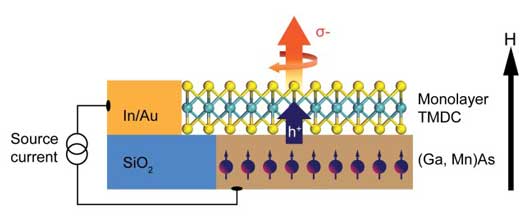| Posted: Apr 04, 2016 |
Scientists push valleytronics one step closer to reality
(Nanowerk News) Scientists with the U.S. Department of Energy’s Lawrence Berkeley National Laboratory (Berkeley Lab) have taken a big step toward the practical application of “valleytronics,” which is a new type of electronics that could lead to faster and more efficient computer logic systems and data storage chips in next-generation devices.
|
|
As reported online April 4 in the journal Nature Nanotechnology ("Electrical generation and control of the valley carriers in a monolayer transition metal dichalcogenide
|
 |
| This schematic shows a TMDC monolayer coupled with a host ferromagnetic semiconductor, which is an experimental approach developed by Berkeley Lab scientists that could lead to valleytronic devices. Valley polarization can be directly determined from the helicity of the emitted electroluminescence, shown by the orange arrow, as a result of electrically injected spin-polarized holes to the TMDC monolayer, shown by the blue arrow. The black arrow represents the direction of the applied magnetic field. (Image: Berkeley Lab)
|
|
Valley electrons are so named because they carry a valley “degree of freedom.” This is a new way to harness electrons for information processing that’s in addition to utilizing an electron’s other degrees of freedom, which are quantum spin in spintronic devices and charge in conventional electronics.
|
|
More specifically, electronic valleys refer to the energy peaks and valleys in electronic bands. A two-dimensional semiconductor called transition metal dichalcogenide (TMDC) has two distinguishable valleys of opposite spin and momentum. Because of this, the material is suitable for valleytronic devices, in which information processing and storage could be carried out by selectively populating one valley or another.
|
|
However, developing valleytronic devices requires the electrical control over the population of valley electrons, a step that has proven very challenging to achieve so far.
|
|
Now, Berkeley Lab scientists have experimentally demonstrated the ability to electrically generate and control valley electrons in TMDCs. This is an especially important advance because TMDCs are considered to be more “device ready” than other semiconductors that exhibit valleytronic properties.
|
|
“This is the first demonstration of electrical excitation and control of valley electrons, which will accelerate the next generation of electronics and information technology,” says Xiang Zhang, who led this study and who is the director of Berkeley Lab’s Materials Sciences Division.
|
|
Zhang also holds the Ernest S. Kuh Endowed Chair at the University of California (UC) Berkeley and is a member of the Kavli Energy NanoSciences Institute at Berkeley. Several other scientists contributed to this work, including Yu Ye, Jun Xiao, Hailong Wang, Ziliang Ye, Hanyu Zhu, Mervin Zhao, Yuan Wang, Jianhua Zhao and Xiaobo Yin.
|
|
Their research could lead to a new type of electronics that utilize all three degrees of freedom—charge, spin, and valley, which together could encode an electron with eight bits of information instead of two in today’s electronics. This means future computer chips could process more information with less power, enabling faster and more energy efficient computing technologies.
|
|
“Valleytronic devices have the potential to transform high-speed data communications and low-power devices,” says Ye, a postdoctoral researcher in Zhang’s group and the lead author of the paper.
|
|
The scientists demonstrated their approach by coupling a host ferromagnetic semiconductor with a monolayer of TMDC. Electrical spin injection from the ferromagnetic semiconductor localized the charge carriers to one momentum valley in the TMDC monolayer.
|
|
Importantly, the scientists were able to electrically excite and confine the charge carriers in only one of two sets of valleys. This was achieved by manipulating the injected carrier’s spin polarizations, in which the spin and valley are locked together in the TMDC monolayer.
|
|
The two sets of valleys emit different circularly polarized light. The scientists observed this circularly polarized light, which confirmed they had successfully electrically induced and controlled valley electrons in TMDC.
|
|
“Our research solved two main challenges in valleytronic devices. The first is electrically restricting electrons to one momentum valley. The second is detecting the resulting valley-polarized current by circular polarized electroluminescence,” says Ye. “Our direct electrical generation and control of valley charge carriers, in TMDC, opens up new dimensions in utilizing both the spin and valley degrees of freedom for next-generation electronics and computing.”
|

